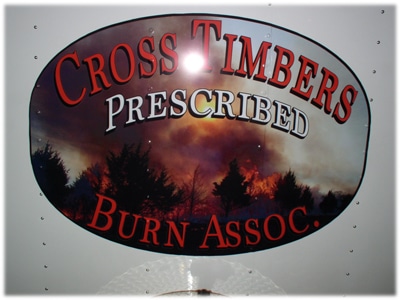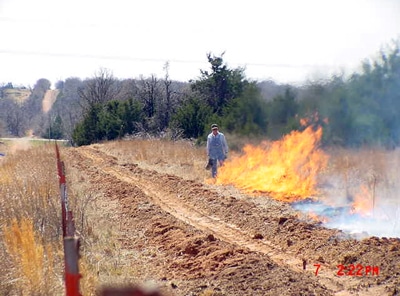Cross Timber Prescribed Burn Association
The Cross Timbers Prescribed Burn Association organized in February 2004 with a primary goal of curbing the invasion of eastern red cedar trees in Lincoln County. The group formed after John Weir from the Natural Resource Ecology and Management Department at Oklahoma State University spoke before a local group of interested land owners and managers. He outlined how an association could be formed to share knowledge, experience, equipment and labor to carry out prescribed burns.

The group organized as a cooperative effort, with neighbor helping neighbor, with approximately 30 members. After the group decided to organize an association, Verlin Hart, a rancher and board member of the Lincoln County Conservation District, was elected president, with Eric Lynch, a local ranch manager as vice president and Gary Bledsoe, an area farmer and retired employee of the Oklahoma Department of Agriculture, Food and Forestry, as secretary/treasurer. Bledsoe has since joined the Lincoln County Conservation District board.
“We wanted to carryout prescribed burning, but we didn’t know how,” Hart said. “We needed training, but had difficulty getting that accomplished. We did not want to burn with a crew that had never seen a prescribed burn,” Hart said. As a result, no burns were conducted the first year.
Burning did begin in February 2005 with assistance from the USDA Natural Resources Conservation Service. Along with some classroom instruction, NRCS conducted two training burns, then the group began burning. “Every burn is considered a training event,” Hart said. Since the association began burning in 2005, it has conducted 45 burns with over 6,000 acres burned.

From the $25 per member annual dues paid, the association has purchased basic equipment needed for conducting burns. Also, a $500 grant from Quail Unlimited allowed for the purchase of additional equipment and a 25-gallon sprayer was donated to the association by P & K Equipment. Kurt Meyer, a Cross Timbers member, donated a motorized leaf blower for association use. In 2008, through the efforts of Mick Jones, Lincoln County OSU Extension Service, along with NRCS, the Wildlife Department and the Lincoln County Conservation District, a grant proposal was made to the OSU Natural Resource Ecology and Management Department. An $8,000 grant was received and two trailers and additional equipment were purchased for use by the burn association. The trailers have been in use during this burn season and have proven invaluable by allowing more burns to be conducted when conditions were right.
Prescribed burning requires planning, Hart said, and cannot be done on the spur of the moment. It’s really best to plan a year in advance for a burn so that there is enough vegetative fuel on the ground to get a fire hot enough to burn red cedars and other invasive species. Where grass is too short, the fire will not ignite trees for an effective burn.
Some of the tasks the association carries out in advance of a burn include:
- Monitor weather conditions through the Mesonet system and news media.
- Communicate with members to assemble a crew for the event.
- Deliver the equipment to the location, ready for use.
- Establish a means of communication for use during the burn (e.g., cellular phones, walkie talkie etc.).
Some of the responsibilities given to land owners or renters who wish to participate include:
- Manage pastures so that there is enough fuel (vegetation) on the ground to carry the fire.
- Develop a prescribed burn plan with NRCS.
- Prepare fire breaks
- Make ready and available any equipment they have on hand (e.g., field sprayer, disking equipment, etc.).
- At least 48 hours before the burn, notify adjoining neighbors, fire and police departments, sheriff’s office, and Highway Patrol if near a highway. Follow up by calling local fire department and sheriff’s office day of the burn.6. Commit to help others with burns.
- Monitor the burned area for up to two to three day following the burn. Be sure no embers from burning debris can carry to surrounding area.
- Replace the fuels used for drip torches and motorized vehicles in the burn.
Hart said even with planning, there is often a small window of time to accomplish a burn, fraught with challenges. The major challenge faced this year was the extremely dry spring and the resulting burn bans that were placed on many counties. “We were able to deal with these by having adequate prescribed burn plans prepared by the local NRCS and a good relationship with the local fire departments in the county,” Hart said. Along with the burn ban, extreme wind has been a major factor this year. There was a very limited number of days when the wind was less than 15 mph and burns cannot be conducted with winds that high.
“Members have been very cooperative to assist when a burn is scheduled,” Hart said. However, most of the members of the burn association work away from their farms and cannot always get off when a burn might be scheduled, so we try to give them as much lead time as possible when scheduling a burn,” Hart said. Since weather is the major factor limiting their ability to burn, they monitor the weather through for two to three days prior to the burn and follow weather predictions closely. When conditions look favorable, an email alert is sent to those members having that service reminding them of a possible burn. Others in the area are notified by phone. “Members have been great to help whenever they can,” he said.

There are some folks, Hart said, who are strongly prejudiced against any burning out of concern for safety or a conviction that it is more damaging than beneficial. “The concern that some feel when they see smoke in the area is understandable since there have been many wildfires in recent years,” he said. “We take our responsibility very seriously and we will not burn if we question the existing conditions.”
In addition to controlling the spread of invasive plant species like eastern redcedar, benefits of burning include enhancing air quality by reducing cedar pollen that triggers allergies for many people. Burning also improves wildlife habitat, improves the quality of forage in native range for better livestock performance, and reduces the threat of wildfire in the area.
Hart and Ed Stinchcomb, NRCS district conservationist at the Lincoln County CD, met recently with interested landowners at Okemah who are thinking of forming a group like the Cross Timbers Prescribed Burn Association.
“We are seeing a lot more interest from people considering prescribed burning as an effective and appropriate resource management tool,” Hart said. “Our goal is to get more people trained in the proper burn procedures and techniques to carry out safe burns,” Hart said. “Groups like the Cross Timbers Prescribed Burn Association go a long way toward helping land managers pool their resources and labor and identify outside resources — financial or educational — to do just that,” he said.
